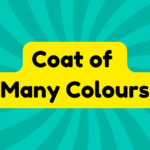The "coat of many colours" symbolizes a complex mix of themes such as diversity and emotional depth, originating from the biblical story of Joseph. This multicolored garment represents favoritism and the ensuing conflict among his brothers. Its significance extends to modern society, where it challenges norms and highlights individual differences. The imagery used prompts reflection on cultural narratives and personal identities. Those interested will find deeper layers and lessons in its enduring relevance.
Synonyms
The phrase "coat of many colours" evokes a rich tapestry of meaning, and its synonyms can enhance the understanding of its significance. Synonyms provide a broader appreciation of the underlying themes present in this vibrant imagery. For instance, words like:
- Multicolored
- Variegated
- Kaleidoscopic
- Chromatic
These terms illustrate the diverse spectrum of vibrant hues, reinforcing the concept of a colorful tapestry woven with intricate stories. Embracing such synonyms encourages a deeper exploration of emotional and cultural narratives, while also prompting a critical examination of how color influences perceptions and connections within society.
Example of Sentences
Examples of sentences incorporating the phrase "coat of many colours" illustrate its broad applicability across various contexts. This concept weaves through discussions of color symbolism and literary adaptations, inviting deeper reflection.
- The artist's vision portrayed a coat of many colours, symbolizing diversity and unity.
- In the novel, the protagonist's coat of many colours represented her rich emotional landscape.
- The play creatively used a coat of many colours to highlight the character's multifaceted nature.
- Critics noted the coat of many colours as a profound element within the story's themes of acceptance.
Each sentence showcases the phrase's potential to convey complex ideas.
Origin
Originating from the biblical narrative found in Genesis, the phrase "coat of many colours" speaks to the favoritism shown by Israel towards his son Joseph. This favoritism holds significant biblical importance, highlighting themes of jealousy and betrayal within Joseph's narrative. The vibrant coat symbolizes not only Israel's affection but also the ensuing conflict among Joseph's brothers, who perceived it as a sign of inequality. Consequently, the coat serves as a metaphor for deeper familial rifts and societal issues, urging readers to reflect critically on the implications of favoritism and its capacity to shape relationships and narratives across generations.
Collocations
Collocations related to the phrase "coat of many colours" highlight its multifaceted use in both language and culture. This phrase embodies color symbolism and carries deep cultural significance, as it stretches across various contexts. Understanding these collocations can deepen one's appreciation for its layered meanings. Some notable examples include:
- Vivid expression of identity
- Rich tapestry of emotions
- Diverse representations of culture
- Symbolic imagery of diversity
Such collocations not only reflect linguistic creativity but also serve as a reminder of how colors can influence perceptions and narratives in both art and everyday life.
How to Use in Everyday Language
Although many may view the phrase "coat of many colours" solely as a colorful metaphor for diversity and uniqueness, its application in everyday language is often misunderstood. Color symbolism and cultural significance intertwine this expression, yet some may misuse it, reducing profound meanings to mere surface appeal. When incorporated thoughtfully, the phrase can enhance discussions about individuality, embracing varied perspectives within a group. However, one must be cautious; oversimplifying it risks trivializing underlying themes of heritage and identity. Ultimately, proper usage demands an awareness of its rich context, ensuring the phrase resonates with its intended depth rather than becoming a tired cliché.
Why Is It Still Relevant Today?
Why does the phrase "coat of many colours" continue to resonate in today's society? This concept retains cultural impact by symbolizing diversity and individuality. It evokes emotional symbolism, representing the richness of human experiences and perspectives. In an era that emphasizes innovation and inclusivity, the phrase challenges conventional norms and encourages appreciation for differences. However, its relevance raises questions about whether society truly embraces the ideals it suggests. While many celebrate diversity, the persistence of stereotypes and exclusionary practices indicates a disconnect. Ultimately, the phrase invites reflection on cultural narratives, urging society to align actions with the vibrant symbolism it embodies.







